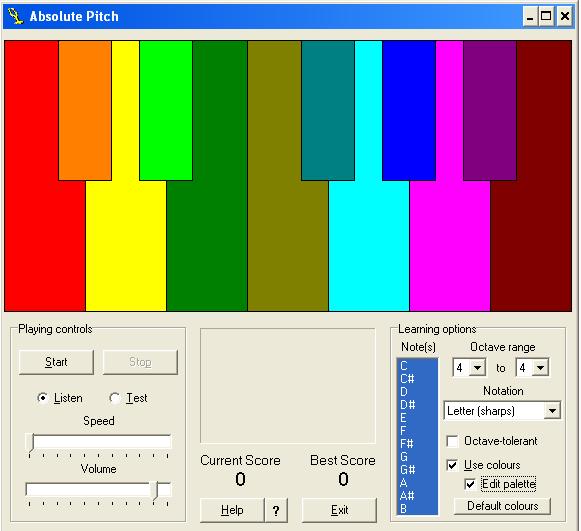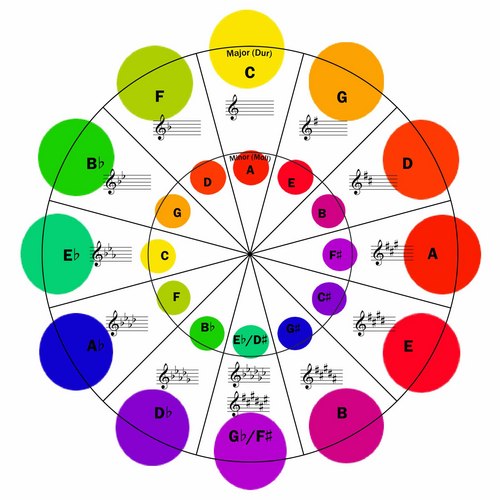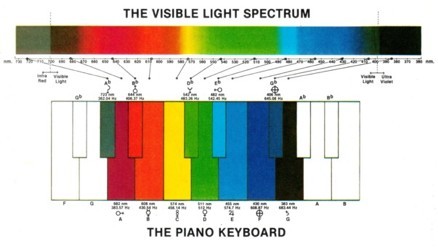
As far as colors go, I've seen others assigned to the notes.
Is any one color "correct" for a particular note, or is this an individual choice? What I want to see is a translation of audio frequencies to visual frequencies. If found this low resolution map which looks interesting, but I don't want to use black and grey as colors. Middle C is 261.626 hertz and
The wavelength of each band of color in the visible spectrum (measured in nanometers, nm) can be halved repeatedly until the rate of its vibration falls within the octaves of the audible spectrum (measured in Hertz, Hz), giving a table of musical notes that correspond to each color (see Figure 2).
Eric L. Wagner of wagneric.com has an interesting analysis with a chart:
Light is a part of the electromagnetic spectrum, higher in frequency than radio waves, but below X-rays. Wavelengths we can see are between approximately 380nm and 780nm. Curiously, the spectrum of visible light, between ultraviolet and infrared, is almost exactly an octave, with the visible edge of ultraviolet having double the frequency (and half the wavelength) of the visible edge of infrared. ...
Corresponding light-spectrum harmonics were computed from equal temperament musical pitches, using a reference of A440 and a half-step frequency ratio of 21/12. Given the speed of light, C = 299792458 meters/second, and λ=C/F, wavelengths were computed for each frequency. The 780.75nm "F" falls outside of the 380-780nm range but I added it for interest. Note that exactly 12 pitches fit within the range. The light spectrum "C" is 41 octaves above middle-C
F -- 349.228231 Hz ~ 383.980501 THz ~ 780.749171 nm
F# -- 369.994423 Hz ~ 406.813170 THz ~ 736.929087 nm
G -- 391.995436 Hz ~ 431.003540 THz ~ 695.568436 nm
G# -- 415.304698 Hz ~ 456.632344 THz ~ 656.529179 nm
A -- 440.000000 Hz ~ 483.785116 THz ~ 619.681028 nm
Bflat -- 466.163762 Hz ~ 512.552476 THz ~ 584.901004 nm
B -- 493.883301 Hz ~ 543.030432 THz ~ 552.073033 nm
C -- 523.251131 Hz ~ 575.320702 THz ~ 521.087555 nm
C# -- 554.365262 Hz ~ 609.531052 THz ~ 491.841158 nm
D -- 587.329536 Hz ~ 645.775654 THz ~ 464.236235 nm
Eflat -- 622.253967 Hz ~ 684.175473 THz ~ 438.180657 nm
E -- 659.255114 Hz ~ 724.858663 THz ~ 413.587466 nm
F -- 698.456463 Hz ~ 767.961002 THz ~ 390.374586 nm
My eye has trouble telling the difference between the different reds, greens and purples in this chart above. Anyway, when I take the visible spectrum and use a ruler in a graphics program and put Middle C exactly in the middle, I get this color, a mix of sun and green grass.
The Real Middle "C"
(html: #7bb81c)



11 comments:
I just started thinking about this last week when I listened to a podcast on the equation E=mc2. I was thinking about the fact that if all matter has an equivalence in energy, then different forms of energy must have equivalents too. I deduced that if A = 440 hrz, then you should be able to double it over and over until the frequency was in the visible light spectrum. As an note of interest, I've recently stumbled across the conspiracy theory about absolute pitch being historically rooted in A-432 instead of A-440. Apparently, A-432 allows the other notes of the scale to fall on whole numbers, instead of partials that run on into infinity. I'm a musician, not a physicist, so I'm a bit out of my league with the number crunching. Anyhow, my question is this: Where will the notes fall on the spectrum if derived from a scale system tuned to A-432? Also, not to drill you too much but do you know anything about this tuning system and if so, does it indeed allow for the notes of the equal tempered system to sit on whole numbers?
I would really love a response to some of this. Loved you in Harry Potter!
Thanks,
Liam.
the math that person did for the pitch color is accurate. you take, for example, A440, multiply it by 2^40 (i think it's 40) and you get a frequency in the visible spectrum. you have to just go with doublings of the frequency, if you're using equal temperment. it would be interesting to follow the natural harmonic series up mathematically, and see how the results differed, but it would take a better man than i.
I've been looking into this from an artist perspective. I'm no mathematician . I find all this helpful because I was trying to match the color wheel ( color spectrum )to the sound spectrum . I'm going to be creating a set of music videos that have colored notes . Each note will have a corresponding color association . One thing I've been looking at is the relationship between wave lengths and force . An example is electricity . Higher volts produce higher penetration like an arc or static >>>>>>> Higher amps produce higher pushing force ))))))))) It's like comparing a bowling ball O ( amps ) to a spear > ( volts ) So I was going to shape each note to the color and shape of the corresponding wave . High frequency being a thin line or small spot . Low frequency being a large spot or wide line/area , mids in between . These associations become much more apparent at the atomic level . Matter is condensed light . Light is a form of electromagnetic wave .Light , color , sound waves , magnetism ,they are all totally connected . It's all about particles and waves and what happens when they contact one another . Ultimately my project is to show a direct relationship between light and sound so everyone understands it without trying to ;-)
This is very interesting stuff
I'm looking at ways of visually representing different types data in outdoor art installations at scale and came across this by chance.
I'm imagining a choir performance with live colour wash on the building behind responding in real-time to the pitch of the music.
You might want to check out my work on youtube . I have a few early attempts at combining music with color and shapes . It's not anywhere near a sync between the two yet though . Like I said very early attempt . My later work will be way more synchronized and tuned to the notes/color frequencies. I'm developing a system for doing these in analog . This is using what's called "a video feedback loop system "
I agree.Most make the mistake of trying to do this in exact terms . It can't be done . It can only be done in a general way as a tool . Like for teaching perfect pitch . Or artistic representation of color as sound . Giving "C" or any other note a particular color that is correct is not possible because the frequencies do not translate in an exact manner. There are several researchers who have attributed various colors to the notes but none totally agree . But they do generally follow a basic plan . That the frequencies match somewhat in spectrum or scale . That is pretty clear . So most start with "C" being orange ,yellow or green . Then going up the scale of color ( light spectrum ) and sound frequency ( both are waves ) . On my diagram I chose yellow for " C " and followed up the scale yellow "C" , Green " D" , " E " blue and so on , http://entertainment.webshots.com/photo/2161405920044363884ObpyIV But this is just my opinion of where I THOUGHT they should go . You can shift it left or right based on what you FEEL . It is more about your own FEELINGS rather than an exact science . But in my opinion they should follow the logical progression of scale . Also there are obvious psychological links between sounds that can confuse the issue or help it depending how you think about it . People tend to perceive red as high frequency ( warning ! , sirens , blood etc )brown usually associated with bass low frequency . Low to mid frequencies are also associated with deep colors like blue or purple .Shapes play an important role also . Sharp shapes associated with sharp sounds ( high frequencies ) round with lower frequencies .
An important note is that some genius minds have been found to have color-graphemic synesthesia, ( letters or numbers are perceived as inherently colored ). It has been proven repeatedly that people learn more by visual means . Like facial and threat recognition( There's a tiger ! and it is going to eat you RUN ! ;-O So shapes and colors are processed faster and more permanently than other inputs . Sound is pretty direct also . Victims often hear their predator before seeing them . This is the primal brain at work .
I read an article here that you posted that said there had been no one found to have gained perfect pitch after age 7 . Pitch recognition seems to be processed similar to language . It's very difficult to learn a new language in later years . And perfect pitch is even harder . So who ever learns perfect pitch in adulthood will supposedly be a first . And they will need to come up with some very clever way of going about it . I figure that is by using all senses , Color , sound and shape . To use as many senses as possible to make as many redundant pathways in the brain . And the visual cortex is the best path of all .
Right, I'm working on it every day but still can't "unlock it" as Jason Mraz says. For him, someone with absolute pitch, "it's just filling in the blanks like madlibs."
That makes sense, it should be easy. We hear examples of the 13 tones every day... We just don't recognize them for what they are because we learned to hear them in the context of the surrounding notes. And I also think many of us grew up around out of tune instruments. My guitar was tuned to itself, not to a correct E A D G B E most of the time I was learning. There is no chance to learn the notes that way.
Sent from my iPhone
That hearing the note in context is a good point .
One thing most people don't realise is the brain doesn't always work in a predictable or what we would consider a logical manner . If you look at people who have super human memory they often have had some sort of brain damage ;-/ Often people like the " Brain Man " Daniel Tammet or Laurence Kim Peek " Rainman " have had brain damage or were born with brain abnormalities . Some have color-graphemic synesthesia . These abnormalities in the brain allowed some to bypass parts of the brain that prevent most of us from having photographic memories . Essentially your brain regulates what you can remember or use . The memories are usually stored but not easily accessible . Some people who have super memory do not have to try. It just pops in and out of memory effortlessly . It's no wonder genius and artistic ability are often associated with mental disorder . That is because it is statistically prevalent . And it has been physically pinpointed to certain brain functions . Here's 3 articles you might find interesting that are related to perfect pitch etc. , mental disorder and their connection http://pn.psychiatryonline.org/content/44/11/17.1.full
http://en.wikipedia.org/wiki/Eidetic_memory
http://www.aip.org/dbis/stories/2004/14291.html
it does not matter if A is set to 440 or 435 or anything else for that matter. this is arbitrary. to assigne colours to musical notes is as simple as dividing the visable spectrum into 12 equal parts. the first division coresponds to the root, the 2nd division is the minor 2nd, and so on. the only reason for 12 parts is that this is the western scale. other cultures have more or less notes making up they're octave(the octave is the same for all scale systems as it is doubleing the frequency by definition). the notion of frequency is redundant altogether in my opinion as it is based on the defination of the second, which was defined by humans to make life easyer, not defined by nature, i mean to say that light, and music (as mathematical ratios) would exist if humans never evolved, the second would not. anyway, it may in fact make more sense to divide the colour spectrum up into 7 parts, one for each note in the major scale. when doing this it is clear that the 1st 3rd and 5th(major chord) form an equlateral triangle on the coulor wheel! what would you get if you mixed three colours separated like this on the colour wheel, purple cyan and orange for example? white maybe?
The color wheel is logically separated into 12 parts . It can be reduced to 6 or 3 . 3 being the primary colors . Comparing the two ( color spectrum and audio spectrum )is not an exact science . But it seems to me that comparing twelve to twelve is a good fit ;-)Not perfect though , like I said not an exact science ;-) But if you would have followed my link to my Color Research diagrams you would have seen that I had split the color spectrum into 7 major and 7 minor .
Here's the link ( again ) to the 7 major 7 minor separation http://entertainment.webshots.com/album/577458124lIGeHkhttp://entertainment.webshots.com/album/577458124lIGeHk
Post a Comment